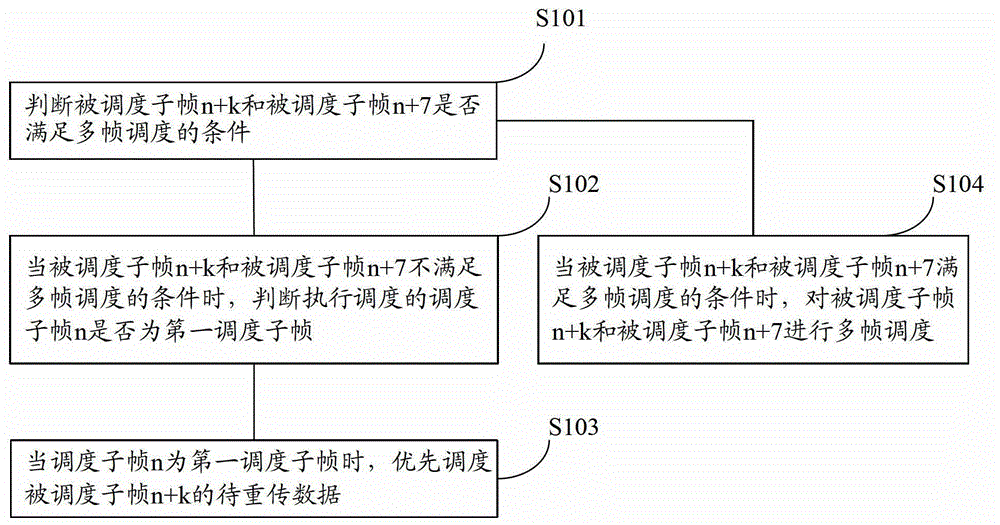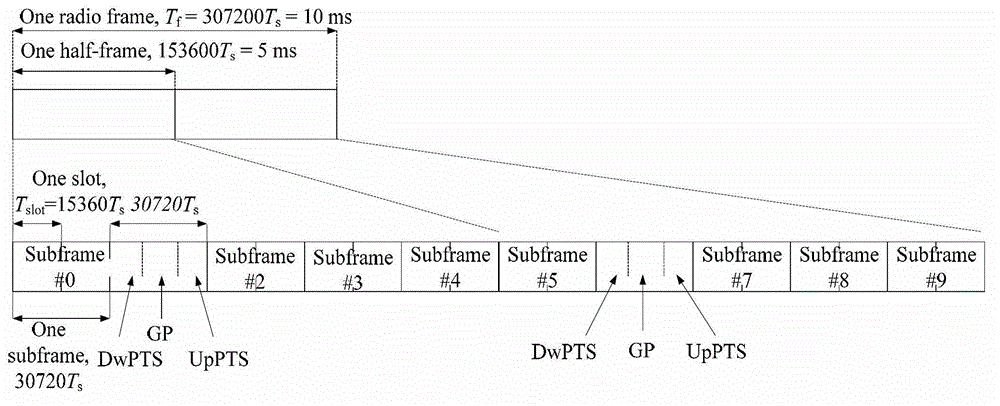A method and device for scheduling retransmission data
A technology for retransmitting data and the number of retransmissions. It is applied in the direction of error prevention/detection, electrical components, and wireless communication using the return channel. Achieve the effect of reducing service transmission delay, improving user perception, and optimizing scheduling methods
- Summary
- Abstract
- Description
- Claims
- Application Information
AI Technical Summary
Problems solved by technology
Method used
Image
Examples
Embodiment 1
[0048] refer to figure 1 , shows a flowchart of a method for scheduling retransmission data according to the present invention, and this embodiment may specifically include the following steps:
[0049] S101, judging whether the scheduled subframe n+k and the scheduled subframe n+7 satisfy the condition of multi-frame scheduling, and if so, execute S104 to perform multi-frame scheduling;
[0050] Where n is the sequence number of the scheduling subframe, k is the time delay between the scheduling subframe and the scheduled subframe, and the time delay is in units of subframes.
[0051] The LTE system is divided into FDD system and TDD system. In 3GPP TS 36.211, two wireless frame structures are defined, namely type1 and type2, which are applied to FDD system and TDD system respectively. The type1 frame structure is as follows: figure 2 As shown, the type2 frame structure is as follows image 3 shown.
[0052] For the type2 wireless frame structure of the LTE-TDD system, se...
Embodiment 2
[0092] refer to Figure 5 , shows a flowchart of a method for scheduling retransmission data according to the present invention, and this embodiment may specifically include the following steps:
[0093] S501, judging whether the scheduled subframe n+k and the scheduled subframe n+7 satisfy the condition of multi-frame scheduling, and if so, execute S506 to perform multi-frame scheduling;
[0094] Where n is the sequence number of the scheduling subframe, k is the time delay between the scheduling subframe and the scheduled subframe, and the time delay is in units of subframes, and the value of k is shown in Table 4.
[0095] In this embodiment, the scheduled subframe n+k and the scheduled subframe n+7 can be judged by judging whether completely consistent resources can be found in the scheduled subframe n+k and the scheduled subframe n+7 to carry the data to be retransmitted respectively. Whether subframe n+7 satisfies the condition of multi-frame scheduling. If exactly the...
Embodiment 3
[0164] refer to Figure 7 , is a structural block diagram of an apparatus for scheduling retransmission data in this embodiment. This embodiment specifically includes the following modules:
[0165] The multi-frame scheduling judging module 1001 is used to judge whether the scheduled sub-frame n+k and the scheduled sub-frame n+7 meet the conditions of multi-frame scheduling, and if so, perform multi-frame scheduling;
[0166] Where n is the sequence number of the scheduling subframe, k is the time delay between the scheduling subframe and the scheduled subframe, and the time delay is in subframes, and the value of k is shown in Table 4.
[0167] The first scheduling subframe judging module 1002 is used to judge whether the scheduling subframe n to be scheduled is the first scheduling subframe when the scheduled subframe n+k and the scheduled subframe n+7 do not meet the conditions of multi-frame scheduling frame;
[0168] The above-mentioned first scheduling subframe judgin...
PUM
 Login to View More
Login to View More Abstract
Description
Claims
Application Information
 Login to View More
Login to View More - R&D
- Intellectual Property
- Life Sciences
- Materials
- Tech Scout
- Unparalleled Data Quality
- Higher Quality Content
- 60% Fewer Hallucinations
Browse by: Latest US Patents, China's latest patents, Technical Efficacy Thesaurus, Application Domain, Technology Topic, Popular Technical Reports.
© 2025 PatSnap. All rights reserved.Legal|Privacy policy|Modern Slavery Act Transparency Statement|Sitemap|About US| Contact US: help@patsnap.com



